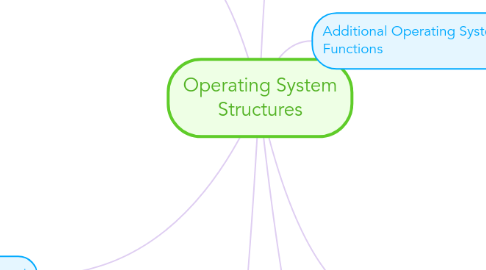
1. Layered Approach
1.1. operating system is divided into a number of layers
1.1.1. layer 0 is the hardware
1.1.2. the highest ( layer N) is user interface
1.2. Advantage
1.2.1. Simplicity of construction and debugging
1.3. Disadvantages
1.3.1. The careful defination and interaction of the layers
1.3.2. Less efficient
2. Microkernel
2.1. Benefits of a Microkernel Organization
2.1.1. Extensibility
2.1.1.1. Allow the addition of new services
2.1.2. Flexibility
2.1.2.1. New features added
2.1.2.2. Existing features can be subtracted
2.1.3. Reliability
2.1.3.1. Modular design
2.1.3.2. Small microkernel can be rigorously tested
2.1.4. Portability
2.1.4.1. Changes needed to port the system to a new processor is changed in the microkernel -not in the other services
2.2. Small operating
2.3. The main function of microkernel is to provide communication facility between user program and various services
2.4. Both user program and service are running on user mode
2.5. However,user program and service never interact directly
2.6. They communicate directly by exchanging message with microkernel
3. Operating System Design
3.1. Operating system Design Goals
3.1.1. User Goals
3.1.1.1. operating system should be convenient to use ,easy to learn ,reliable,safe,and fast
3.1.2. System Goals
3.1.2.1. operating system should be easy to design ,implement,and maintain,as well as flexible,reliable,error-free ,and efficient
3.2. Start by defining goals and specifications
4. Operating system services
4.1. User interface
4.2. Program execution
4.3. I/O operations
4.4. File-system manipulation
4.5. Communications
4.6. Error detection
5. Additional Operating System Functions
5.1. Resource allocation
5.2. Accounting
5.3. Protection and security
6. System Calls
6.1. provide the interface between a running program and the operating system
6.2. application program to invoke a function provided by os
6.3. Types of system calls
6.3.1. Process Control
6.3.1.1. create process,terminate process
6.3.2. File management
6.3.2.1. create file ,delete file
6.3.3. Device management
6.3.3.1. Request device,release device
6.3.4. Information maintenance
6.3.4.1. Set time and data
6.3.5. Communications
6.3.5.1. create/delete communication connection
6.3.6. Protection
6.3.6.1. Set permmision
7. Communications Models
7.1. Message Passing
7.1.1. In message passing model ,communication takes place by mean of messages exchanged between the process
7.2. Shared memory
7.2.1. In shared memory that is shared by process can exchange information by reading and writing data to the shared region

